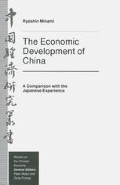Abstract
When the People’s Republic of China (PRC) was established in 1949 it was a typical agrarian society with 92 per cent of its population living in rural areas. Modern industry was no more than a few recognisable islands in a vast ocean of agriculture and small businesses. Years of war had severely damaged industry and it did not recover to its prewar record level until 1952. Even then China’s pig iron output was only 1 930 000 tons, the level Japan had reached in 1935, the output of steel was 1 350 000 tons, equal to Japan’s in 1933, and total electricity production was 73 billion watts, the volume generated by Japan in 1924. China’s 1952 grain output was 1.6 billion tons, less than half of what it now produces. Overall, China’s industrial level, including in the northeast area where Japan invested heavily during the Manchurian period, was lower than that of Japan.1
Access this chapter
Tax calculation will be finalised at checkout
Purchases are for personal use only
Preview
Unable to display preview. Download preview PDF.
Notes and References
For more information on this, see Ryōshin Minami, Dokoe Iku Chugoku Keizai (Where is the Chinese Economy Going?) ( Tōkyō: Nihon Hyōronsha, 1985 ), pp. 16–17.
For more on China’s primary conditions, see Alexander Eckstein, China’s Economic Development (Ann Arbor: The University of Michigan Press) 1975, Ch. 5, China’s Economic Revolution (Cambridge University Press, 1977), Ch. 1, and T. G. Rowsky, Economic Growth in Prewar China (Berkeley, Los Angeles and London: University of California Press, 1989), Ch. 1.
For more on Chinese economic history, see Liu Suinian and Wu Qungan (eds), Zhongguo Shehuizhuyi Jingji Lueshi (A Brief History of the Chinese Socialist Economy) (Beijing Zhoubaoshe [Beijing Review Press], 1986).
For a comparison of the economic growth of India and China, see Wilfred Malenbaum, ‘Modern Economic Growth in India and China: The Comparison Revisited, 1950–1980’, Economic Development and Cultural Change, Oct. 1982.
Harry T. Oshima, Economic Growth in Monsoon Asia: A Comparative Survey (University of Tōkyō Press, 1987), Table 9. 1.
Author information
Authors and Affiliations
Copyright information
© 1994 Ryōshin Minami
About this chapter
Cite this chapter
Minami, R. (1994). Economic Development and Achievement: An Overview. In: The Economic Development of China. Studies on the Chinese Economy. Palgrave Macmillan, London. https://doi.org/10.1007/978-1-349-23172-0_2
Download citation
DOI: https://doi.org/10.1007/978-1-349-23172-0_2
Publisher Name: Palgrave Macmillan, London
Print ISBN: 978-1-349-23174-4
Online ISBN: 978-1-349-23172-0
eBook Packages: Palgrave Economics & Finance CollectionEconomics and Finance (R0)

